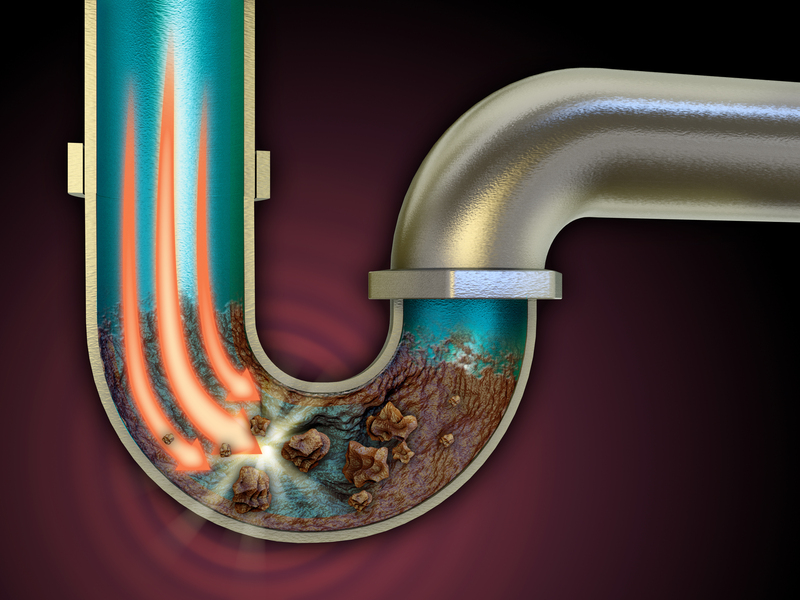Conquer Grease: A Hassle-Free Guide to Cleaning Enamel Oven Trays
Posted on 22/09/2025
Conquer Grease: A Hassle-Free Guide to Cleaning Enamel Oven Trays
Are stubborn, built-up grease stains on your enamel oven trays making baking less enjoyable? You're not alone! Many home cooks wrestle with keeping oven trays clean, often resorting to harsh chemicals or giving up altogether. In this comprehensive guide, we'll walk you through hassle-free strategies to clean enamel oven trays effectively--leaving them gleaming, odor-free, and ready for your next culinary adventure.

Why Is It Important to Clean Enamel Oven Trays?
Enamel oven trays are highly valued for their durability and heat resistance. Yet, over time, layers of grease and food residue can accumulate, leading to charred stains and compromised cooking performance. Proper enamel tray cleaning is essential to:
- Prevent unpleasant smells from burnt-on grime.
- Reduce the risk of fire hazards due to grease buildup.
- Maintain the non-stick qualities of enamel surfaces.
- Promote better-tasting food by avoiding flavor contamination.
- Extend the lifespan of your oven accessories.
Let's explore methods and tips that'll help you conquer grease and keep your enamel oven trays looking like new.
Understanding Enamel Oven Trays
Enamel oven trays have a metal core--typically steel or aluminum--coated in a smooth, glassy layer of enamel. This enamel surface is non-porous, easy to clean, and resistant to rust. However, it can get discolored and lose effectiveness when not maintained. Knowing how to care for enamel is the first step towards a grease-free, sparkling oven tray.
Key Features of Enamel Oven Trays
- Non-reactive coating: Doesn't retain smells or flavors.
- High resistance to heat and scratches: Less likely to warp or degrade.
- Smooth finish: Makes it harder for food to stick--when cared for properly.
But enamel is not invincible! Avoiding abrasive scrubbing and harsh chemicals will help keep your tray in top shape.
Common Challenges: What Makes Grease So Stubborn?
Grease and burnt food residues can be tenacious, especially after repeated oven use. The high temperatures carbonize oil, adhering stubborn stains to your tray's enamel surface. In some cases, improperly cleaned trays develop blackened patches or sticky zones that seem impossible to remove.
The main obstacles to cleaning enamel oven trays include:
- Layered, baked-on fat and oil requiring more than a quick rinse.
- Tough, carbonized grime that can dull the enamel's shine.
- Dried-on food bits stuck in corners and edges.
With the right tools and cleaning agents, however, you can restore your enamel oven tray efficiently, without damaging its valuable surface.
Tools & Materials for Easy, Effective Cleaning
Before you begin, gather these supplies for a grease-conquering clean:
- Warm water
- Mild dish soap
- Baking soda
- White vinegar
- Non-abrasive sponge or soft cloth
- Plastic scraper (optional)
- Old toothbrush (for corners and beads)
- Rubber gloves (for sensitive skin)
*Avoid steel wool or metal scouring pads--they can scratch and permanently damage the enamel coating.
Step-by-Step Guide: How to Clean Enamel Oven Trays
1. Remove Loose Debris First
- Start by scraping off chunks or flakes of food with a plastic scraper.
- Shake into your bin or compost before rinsing the tray with warm water.
2. Soak the Tray for Easy Grease Removal
- Fill your sink (or tub, for larger trays) with hot, soapy water.
- Allow the tray to soak for at least 30 minutes. If you have heavy buildup, overnight soaking works wonders.
3. Apply a Baking Soda Paste
- Make a thick paste of baking soda and water.
- Spread over stubborn, greasy areas and allow to sit for 15-30 minutes.
- The gentle abrasiveness of baking soda lifts grease without harming enamel.
4. Scrub Gently for Best Results
- Use a non-abrasive sponge or soft cloth to scrub affected areas in circles.
- Employ an old toothbrush for grooves or corners.
- For ultra-stubborn grime, add a drop of dish soap directly to your brush or sponge.
5. Tackle Odors and Discoloration With Vinegar
- Spritz white vinegar onto the tray, especially where grease or stains linger.
- Let sit for several minutes; vinegar neutralizes odors and helps break down fats.
- Rinse thoroughly with warm water.
6. Rinse & Dry Properly
- After cleaning, rinse your enamel oven tray well to remove any residue.
- Use a soft towel to dry completely, or let air dry upright.
Alternative Deep Cleaning Methods
For extra-tough, blackened enamel trays, try the following:
Boiling Water and Baking Soda
- Place the tray in your sink and pour boiling water over it.
- Sprinkle liberally with baking soda.
- Let it fizz and soak for up to an hour, then scrub as above.
Hydrogen Peroxide and Baking Soda Paste
- Mix a thick paste of hydrogen peroxide and baking soda.
- Apply to the grimiest zones; let sit 20-30 minutes before scrubbing.
- Hydrogen peroxide acts as a gentle bleaching agent for stubborn stains.
Oven Cleaner (Use with Caution)
- Only for trays with extreme buildup--read enamel tray manufacturer's instructions first.
- Choose enamel-safe oven cleaners and use sparingly. Rinse thoroughly after application.
Pro Tip: Never put hot trays directly into cold water--this can cause enamel to crack or chip!
What to Avoid When Cleaning Enamel Oven Trays
- Do not use steel wool, metal brushes, or sharp tools.
- Steer clear of harsh chemical bleaches or chlorine-based cleaners.
- Do not run cold water over a hot tray.
- Avoid soaking for days at a time--prolonged immersion can affect enamel bond.
Abrasion will erode the glossy enamel finish, making future cleaning even harder and possibly leading to rust beneath the enamel layer.
Tips for Preventing Stubborn Grease on Enamel Trays
With proper habits, you can reduce future buildup and keep cleaning effortless:
- Line trays with parchment paper or a reusable silicone mat before roasting greasy foods.
- Wipe spills promptly before they have a chance to bake on.
- Clean trays after each use--don't allow residue to accumulate over weeks.
- Use proper oven temperature and avoid burning foods, which causes tough, carbonized grease stains.
- Store enamel trays dry and upright to promote even airflow and prevent mold or rust.
Frequently Asked Questions About Enamel Oven Tray Cleaning
Is it safe to put enamel oven trays in the dishwasher?
Most enamel trays are technically dishwasher safe. However, repeated high-temperature cycles, harsh dishwasher detergents, or crowded racks can dull the enamel or cause chipping. For best results, stick to gentle hand-washing.
Can you use lemon juice to clean oven trays?
Yes! Lemon juice has natural degreasing abilities and leaves behind a fresh scent. Mix it with baking soda or vinegar for enhanced cleaning power on greasy stains.
Are commercial oven cleaners safe for enamel trays?
Some are, but be sure to read the label for enamel compatibility. Always use in a well-ventilated area and rinse thoroughly to avoid leaving chemical residues on cooking surfaces.
How do I remove burnt-on sugar or caramel?
Soak the tray in hot water to soften the residue, then gently scrape with a plastic spatula. Follow up with baking soda paste for any lingering stains.
Bonus Section: Natural Cleaning Solutions for Enamel Oven Trays
If you prefer eco-friendly options, try these green alternatives:
- Baking Soda and Vinegar Reaction: Sprinkle baking soda on the tray, spray with vinegar, let fizz for 10 minutes, then scrub.
- Coarse Salt and Lemon: Cut a lemon in half, dip the cut side in salt, and use to scrub the greasy tray.
- Paste of Cornstarch and Water: This mild abrasive cleans without scratching.
The Power of Steam
Place the tray in your oven and set a heatproof bowl of water beneath it. Turn the oven to 200?C (400?F) for 20 minutes. The steam looses stuck-on grease, making subsequent cleaning even easier!

Summary: The Foolproof Routine for Sparkling Enamel Oven Trays
Cleaning enamel oven trays doesn't have to be a dreaded chore. With a little planning and know-how, you can say goodbye to baked-on grease and unpleasant odors. Let's recap the ideal cleaning routine:
- Scrape off loose food debris before soaking.
- Soak fully in hot soapy water--ideally after each use.
- Use a baking soda paste for tough, greasy areas.
- Scrub gently using non-abrasive tools.
- Employ vinegar or lemon juice as natural degreasers and deodorizers.
- Rinse and dry immediately to preserve the enamel's integrity.
- Line enamel trays to prevent major messes in the future!
Conclusion: Conquer Grease with Confidence
Armed with these strategies and tips, you can clean, maintain, and protect your enamel oven trays for years to come. Choose gentle methods over harsh chemicals, utilize household staples like baking soda and vinegar, and make tray cleaning a regular habit. Conquer grease with confidence, and keep your kitchen shining--no more dread, just delicious results!
For more home care tips, oven maintenance hacks, and troubleshooting help, bookmark this guide to cleaning enamel oven trays and share it with fellow baking enthusiasts!




